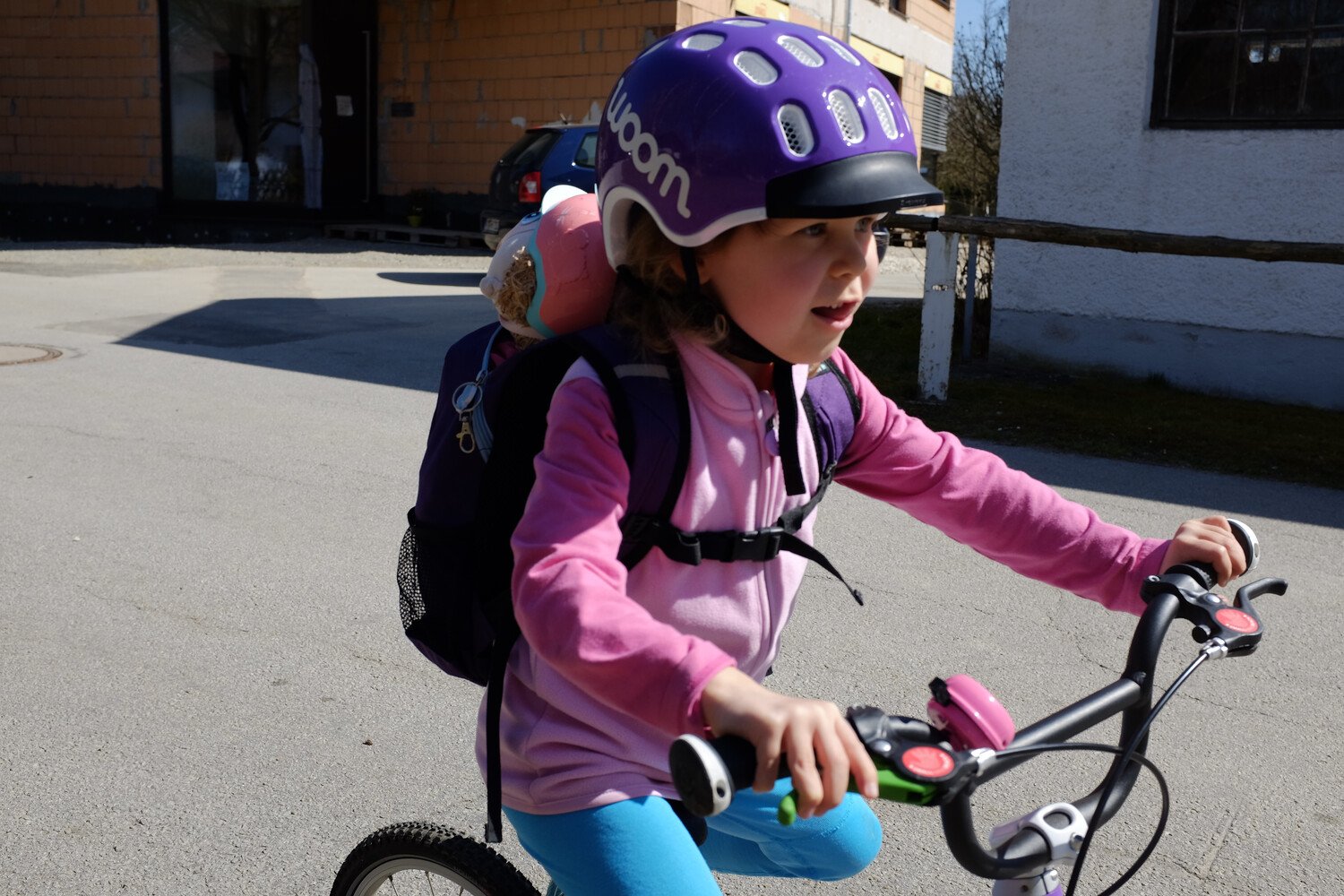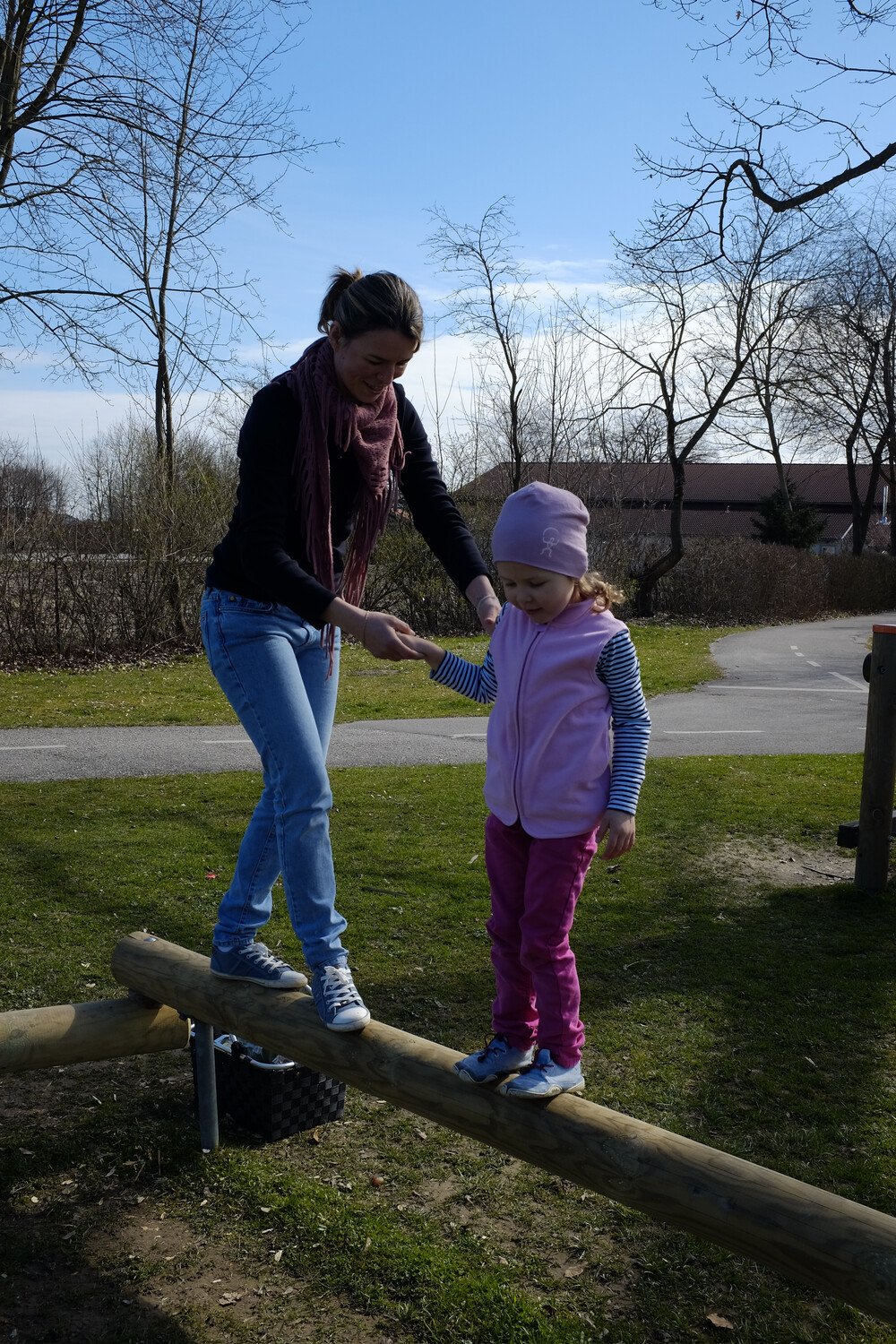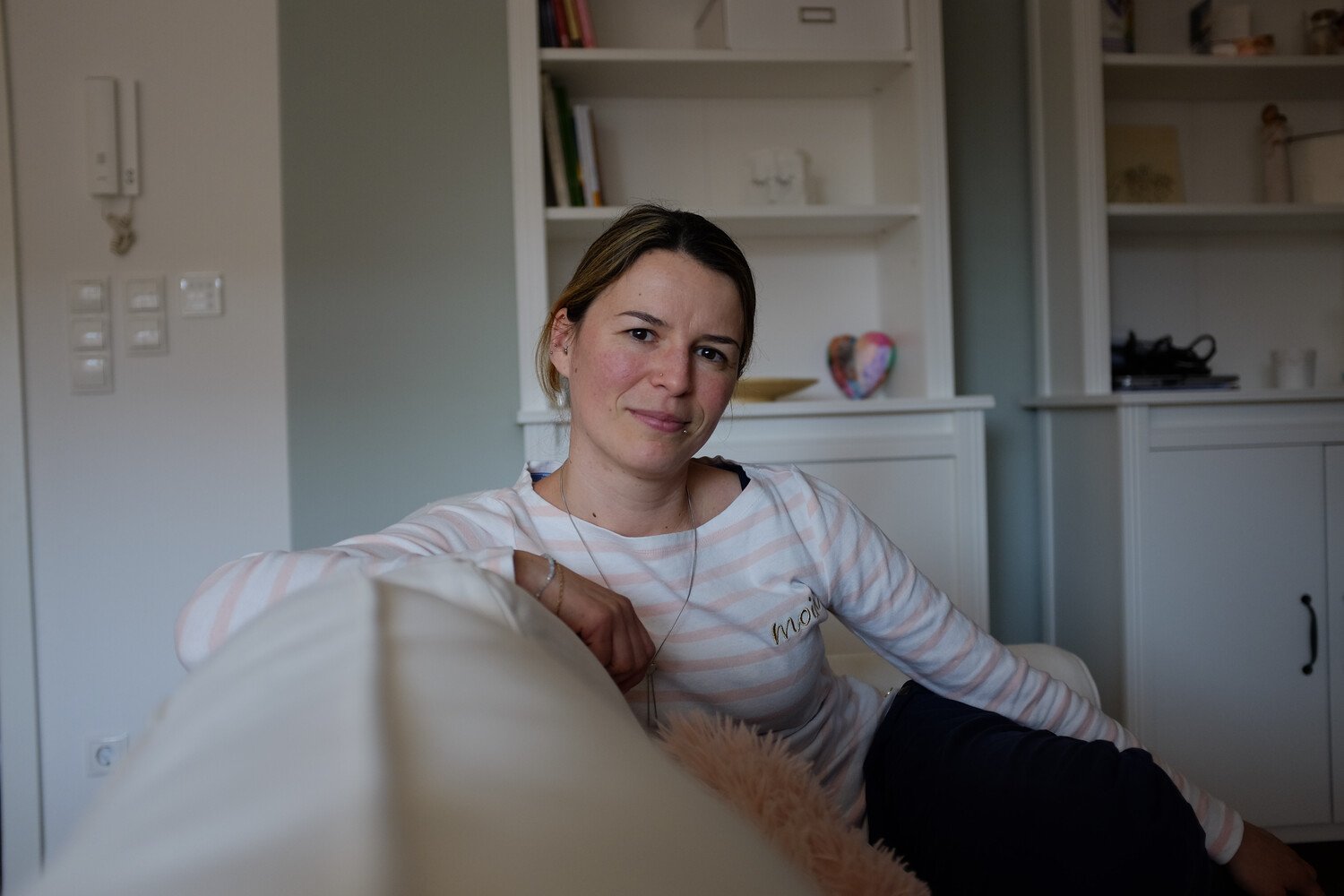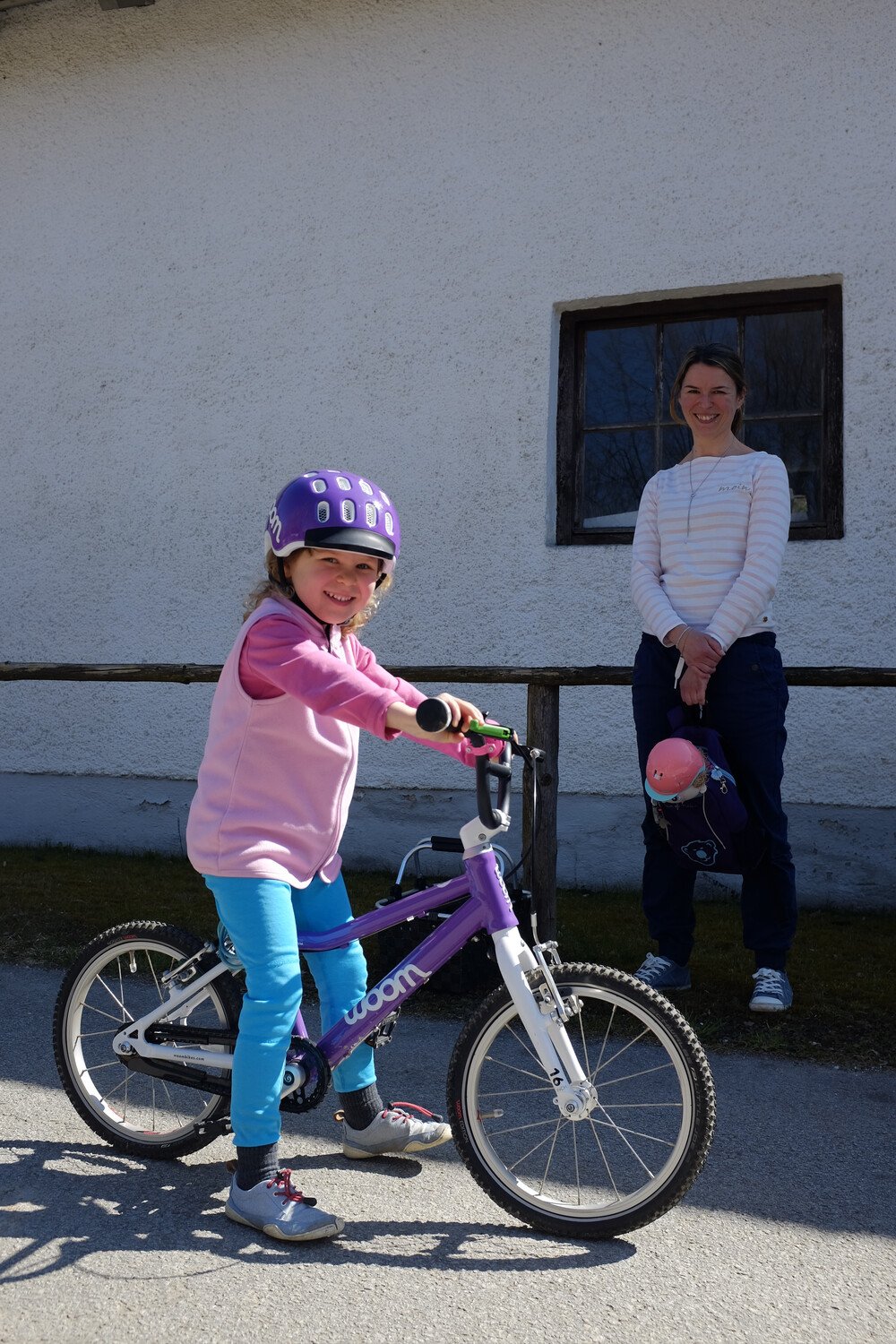Riding against rheumatism
Four-year-old Alida suffers from rheumatism. Almost a year of cycling has given her self-esteem a huge boost and made life so much easier for her little family.

"Look, mummy! There's a butterfly!" shouts Alida before swinging her leg over her purple bike and jumping in the saddle. A few metres on, she spots a flower bed on a little roundabout. The bright-yellow primroses couldn't have been watered long ago since the earth around them is still dark. Alida pulls on the brakes like a pro, coming to a stop to get a closer look. Oblivious to the noise coming from the nearby building site, she admires the pretty petals for a moment. And then she's ready to move on... "Are we going to the park now, Mummy?"
The park is one of their daily ports of call in Kirchham, a village in Lower Bavaria that is home to 2400 people. Their nearest little shop, or the village supermarket as they call it, is on their route too. Alida places one foot after the other on a long wooden beam that is half a metre off the ground and finds her balance. Her mum, Daniela Brenzinger, can't hide her pride. Now, balancing on a 20-cm-thick beam may not be a big deal for most children at the age of four. But it is a huge challenge for Alida, who was diagnosed with childhood rheumatism almost three years ago, not long before her second birthday.
Lots of different health conditions are classified as rheumatism, but the term is mainly used to refer to disorders affecting the joints when the cause is unknown. To be more specific, Alida suffers from juvenile idiopathic arthritis, which causes joint pain in children under the age of 16. Around one in 1000 children is affected by this condition in Austria.
Alida's mum has been on constant high alert since the diagnosis. The 35-year-old carefully watches her daughter's movements even as she is balancing, checking that Alida is steady and that her joints are working as they should be. One warning sign she can look out for is her daughter trying to change her posture to relieve pain instead of complaining about it.
Their days are by no means as tough as they used to be. The joint pain may be gone for now, but Alida is currently suffering from eye inflammation, which is a common problem amongst young children with rheumatism. In the most serious cases, it can even cause blindness. Regular trips to the doctor and medication keep Alida from living life like any other child. But at least she isn't struggling with pain at the moment.
However, that hasn't always been the case. Rheumatism is a chronic illness, which can flare up again at any point. When this happens, the symptoms usually last for around six weeks. Daniela remembers Alida being lethargic and simply not wanting to move at all when her disorder was at its worst. Her wrists and knees were swollen, with her right wrist contorted into an unnatural position on one side in an attempt to relieve the pain.
Parents can usually tell that a young child's rheumatism is about to flare up when they want to be carried more, when their voice is hoarse or when they can't button up their clothes when getting dressed in the morning because their fingers are too stiff. But they still can't predict the exact timing of the joint pain at that point. Treatment aims to prolong the periods without any pain and inflammation as much as possible. And those happy, pain-free windows can last several years at a time. But sometimes they are over within a matter of weeks.
At the moment, Alida goes weeks without any pain. She lives with her mum Daniela in an apartment on a farm. It's a sunny weekend at the end of March when I visit them. With the sound of the birds outside singing in the background, the sun shines through their open balcony door and onto Alida's hair, which is, as always, a bit of a mess. The young girl keeps pushing her hair off her face with her left hand. In her right hand, she is pushing a small toy vehicle back and forth on the kitchen table. It's an ambulance
"Again! This time, you can be Alida and I'll be the doctor," says Alida, explaining the game to me. "You have to say that your joints hurt," she tells me. This is the fifth version of the scene we've been acting out. The setting is always the same, but the characters do things a little differently each time. In this round of the game, I'm pretending to be Alida, who is picked up by the ambulance and taken to the hospital. "Now you're going into the tube to be examined," shouts the little girl.
The scene Alida is happily playing out here is actually more or less spot on. After Alida's parents first noticed the swelling, Daniela and Alida had to spend eight weeks at the hospital whilst tests were being run. Eventually, they ended up at the German Centre for Paediatric and Adolescent Rheumatology in Garmisch-Partenkirchen. Alida was given an injection every day to help with the pain.
"Not every patient with joint inflammation or pain is diagnosed with rheumatism," explains Dr Michaela Sailer-Höck from the Paediatric and Adolescent Rheumatology Ward at Innsbruck University Hospital. There is a long list of other causes of joint inflammation, including slapped cheek syndrome and flu viruses. "These alternatives have to be ruled out before we even start thinking about juvenile idiopathic arthritis," says the doctor. It often takes longer to diagnose the disorder in young children as it is hard for them to describe the pain with enough precision. They often end up relieving the pain through their posture and positioning, which delays their referral to a specialist," says Sailer-Höck.
Even as we are playing with the ambulance at the kitchen table, Daniela is keeping a close eye on her daughter's posture. She points out to me that Alida leans strangely to the side when she is manoeuvring the ambulance around a corner. "That's a lasting effect from the first time her rheumatism flared up badly – it will never disappear entirely," says the former office assistant. If Alida's posture were to change again, it would mean that her pain had returned.
Her mother still gives her a weekly dose of methotrexate (MTX) to help prevent the next onset of rheumatism symptoms. This medication suppresses the immune system and is also used to treat some cancers and other diseases.
"There is no real cure for rheumatism because we still don't know what actually causes it," explains rheumatology specialist Sailer-Höck. But medication does allow people who suffer from rheumatism to live a relatively normal life. The approach to treatment has shifted over the past 20 years. Whilst taking it easy was always considered the best approach before, experts like Sailer-Höck now recommend staying active during pain-free periods. Some of her patients even go skiing – as long as they take care not to put too much strain on their joints.
The mental health impact of rheumatism
"To start with, I was very cautious and keen for Alida to take it easy. But now I realise that activity does her the world of good," explains Daniela. It's just a case of working out which type of exercise is most suitable. Walking simply doesn't work for Alida. As soon as the little girl became too heavy to be carried, the walk to the village supermarket in Kirchham became a repeatedly frustrating experience. "Time and time again, she had to tell me that she just couldn't carry on," recalls Daniela. "Moments like that and all the many memorable moments at the hospital, like when we had to give her an injection that she didn't want, really knocked her confidence," says Daniela, well aware of the impact on her daughter's mental health.
At the start of our chat, Alida is really quite shy. She starts off by whispering her answers to my questions in her mum's ear. Her mum then has to relay them to me, acting almost like an interpreter. Alida also has her baby doll (Emma) by her side. Once we have got to know each other a bit better, Alida starts to let Emma answer for her. Her baby voice is higher and softer than her normal voice. The longer she speaks in the baby voice, the more often she reverts to her own voice. At some point, she starts speaking only in her own voice. Baby Emma just sits next to her like a supportive friend after that.
Cycling boosts self-esteem
As mum and daughter spent each day battling the effects of Alida's rheumatism, they didn't realise that a turning point was just around the corner... When Alida turned four, she was given a bike as a gift. She wanted to try it out there and then, so she unpacked it bright and early that morning. By seven o'clock, she was sitting on her bike for the very first time. "With a little bit of help, she was soon off and on her way," recalls Daniela. Alida's mum searches through some old videos and quickly finds one of that first bike ride. I watch as Daniela walks alongside her daughter on her bike, just a few metres away. She places her hands lovingly on her back, pushing her gently to get the momentum going. But Alida doesn't need any help once she's on her way. Giggling and laughing out loud, she cycles away, swerving a little unexpectedly before braking just in front of a meadow.
Daniela explains that she picked a woom bike because of the light weight: "Alida can't lift anything too heavy. She felt capable and confident from the beginning, knowing that she could lift the bike without needing any help."
Exercise and activity have now become a huge part of the little girl's day. At her forest kindergarten, all of the children stay outside whatever the weather. And ever since Alida has been zipping about on her own bike, the trips to the village supermarket have been no trouble at all. In fact, they have become great adventures! She stops at another garden fence, behind which some chickens are clucking. Then she lets me in on another secret – that she plays a game called 'run until you fly' with the other children at forest kindergarten. She even tells me about her future career plans: "When I grow up, I want to be a doctor".
Text & Foto: Katharina Brunner


